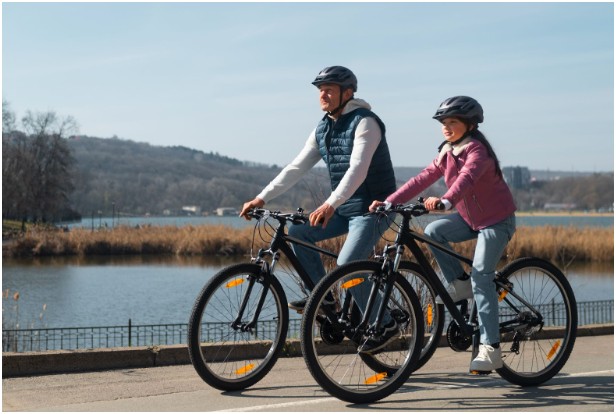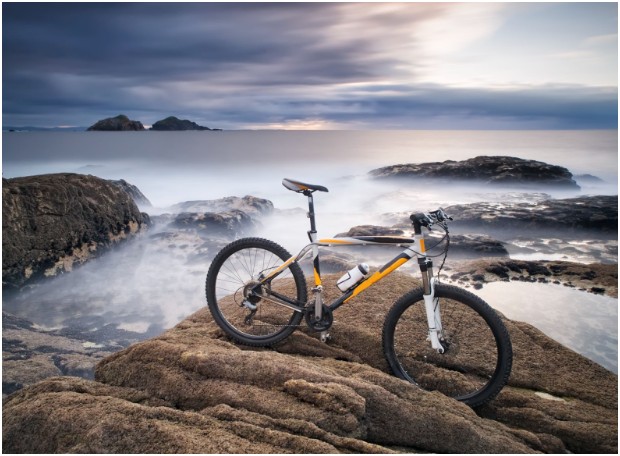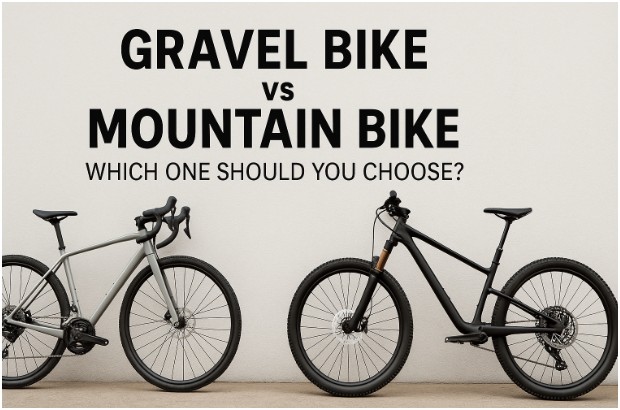When I first started riding mixed terrain, I found myself stuck in the classic debate: gravel bike vs mountain bike. Both looked like they could handle my weekend adventures, yet they promised completely different experiences.
If you’re trying to decide between the two, this guide will break down the key differences—geometry, tyres, suspension, speed, and real-world use—so you can confidently pick the bike that suits your style.
Quick Comparison Table
| Feature | Gravel Bike | Mountain Bike (Hardtail/XC) |
| Typical Tyres | 38–50 mm (some clear 57 mm) | 2.1–2.4 in |
| Wheel Size | 700c or 650b | 29” or 27.5” |
| Handlebars | Drop bars (aero, multi-hand positions) | Flat bars (stable, upright control) |
| Suspension | Rigid (some have mini-suspension) | Front suspension (100–120 mm travel) |
| Speed on Pavement | Faster | Slower |
| Control on Rough Trails | Moderate | Excellent |
| Weight | ~18–23 lbs | ~25–30 lbs |
| Best For | Long mixed-surface rides, commuting | Technical singletrack, trail riding |
How Do Geometry and Fit Differ?

Geometry defines how each bike feels under you. frames are built with a longer reach, lower bottom bracket, and steeper head angle, giving them a stretched, aerodynamic position. The drop bars allow multiple hand positions and reduce wind resistance on long rides.
By contrast, frames have slacker head angles, shorter reaches, and flat bars that put you in an upright position. This boosts control on steep or rough trails and makes quick maneuvers easier. If your riding involves lots of technical turns or obstacles, MTB geometry will feel much more stable.
Tyres and Wheels: Speed vs Traction
Tyre choice is one of the most obvious differences. Gravel bikes usually run 38–50 mm tyres, though many modern frames can now clear up to about 57 mm (2.2″).
These tyres roll fast on pavement and hardpack while still offering grip on loose gravel. Riders can choose 700c wheels for speed or 650b for more comfort and traction.
Mountain bikes run much wider tyres (2.1–2.4″), offering tons of grip on roots, rocks, and loose dirt. Their lower tyre pressure and aggressive tread patterns help absorb impacts, but they roll slower on pavement. If your route involves chunky trails, MTB tyres will keep you confident and stable.
Drivetrain and Suspension: Simplicity vs Capability
Gravel bikes generally use 1x or 2x drivetrains with tighter gear steps, designed for maintaining speed on varied surfaces. Most are fully rigid, though some have subtle comfort features like mini-suspension or carbon flex seat stays to reduce vibrations.
Mountain bikes almost always use 1x drivetrains with very wide gear ranges, helping you climb steep trails at low speeds. Front suspension (100–120 mm for XC bikes, up to 140 mm on trail bikes) smooths out big bumps and hits. That suspension adds weight, but it’s a game-changer for rough terrain.
When to Use a Gravel Bike vs Mountain Bike

Gravel bikes shine on long-distance rides that mix pavement, dirt roads, and light singletrack. They’re fast, efficient, and perfect for commuting, fitness rides, and endurance events. You can even turn them into bikepacking machines with racks and bags.
Mountain bikes dominate technical terrain—roots, rocks, steep climbs, and descents. They’re slower on roads, but nothing beats their control when things get rough. If most of your riding involves singletrack or gnarly forest trails, a mountain bike is the clear winner.
What’s New in 2025
- Gravel frames are now often built with clearance for 2.1–2.2″ tyres.
- More brands are adding in-frame storage and comfort suspension systems.
- Lightweight XC mountain bikes are approaching sub-23 lbs builds, making them more versatile than ever.
FAQs About Gravel Bike vs Mountain Bike
-
Can I ride singletrack on a gravel bike?
Yes, but cautiously. Gravel bikes can handle smooth, green-rated singletrack, especially with wider tyres. However, technical trails with drops, rocks, or roots are better suited to a mountain bike’s suspension and geometry.
-
Is a mountain bike slower on gravel roads?
Usually, yes. The wider tyres and suspension create more rolling resistance, so mountain bikes are slower on smooth gravel. However, they’re more stable on rough, loose, or muddy gravel where a gravel bike might struggle for traction.
-
Which bike is better for bikepacking?
Both can work. Gravel bikes are great for covering long distances quickly on dirt roads and light trails, while mountain bikes excel if you’re carrying heavy gear into rugged backcountry terrain. Consider your terrain first, then your speed goals.
-
Do I need two bikes or just one?
If most of your riding is smooth mixed terrain, a gravel bike with two wheelsets (one with slick tyres, one with knobby tyres) can be super versatile. If your riding includes technical trails, it’s better to invest in a mountain bike.
Final Thoughts: Picking the Right Ride
When it comes to gravel bike vs mountain bike, the right choice depends on your terrain, goals, and riding style. Gravel bikes excel on long, fast rides across mixed surfaces, while mountain bikes offer confidence and control on technical trails. If you want versatility and speed, go gravel.
If you crave adventure on rough terrain, go mountain. Either way, you’ll end up with a bike that fuels your passion for riding—and that’s what matters most.






